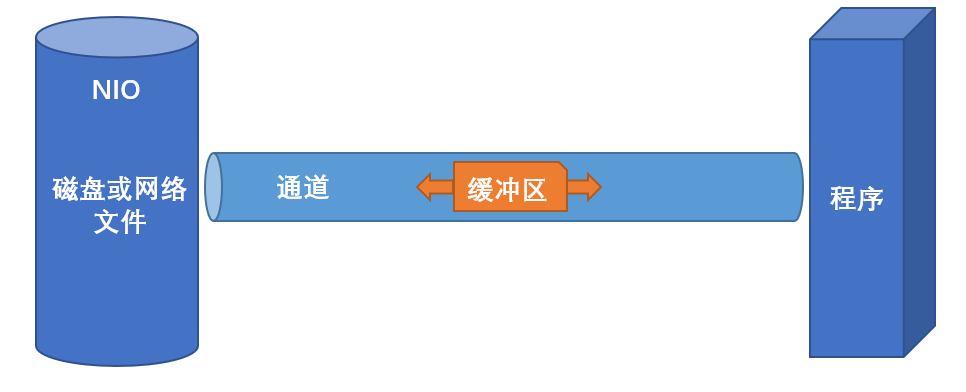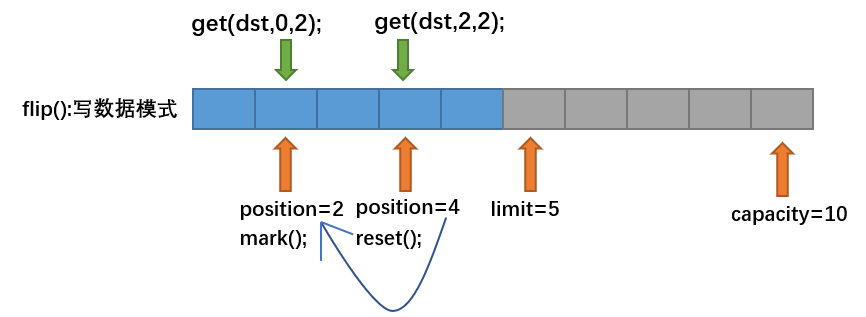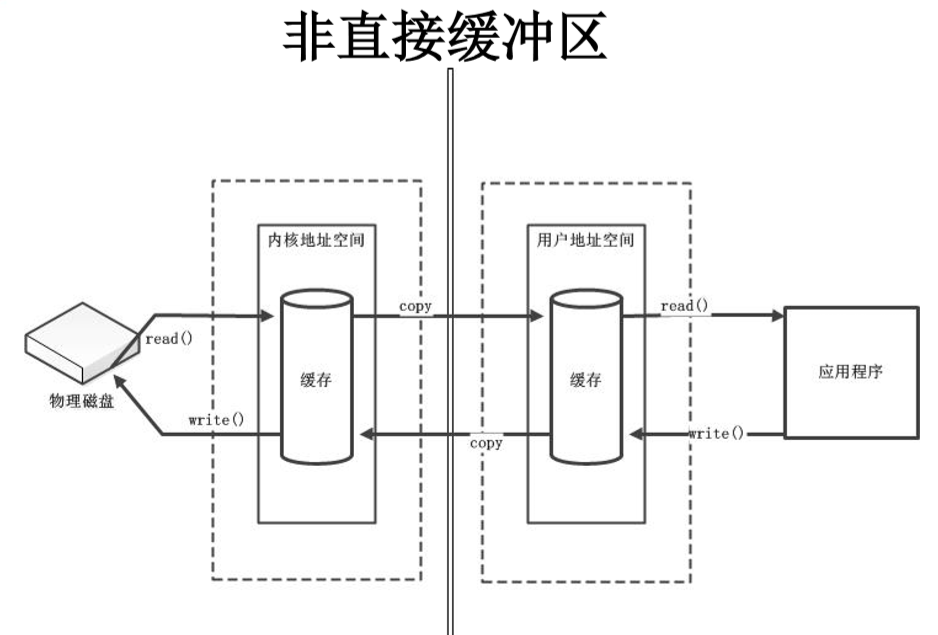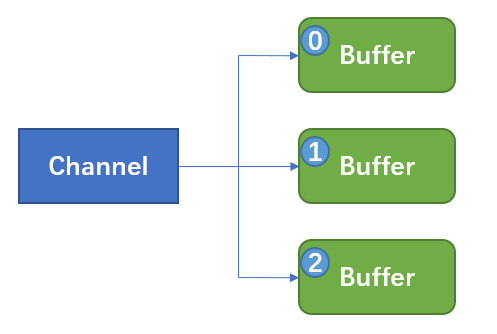一、Java NIO 简介 Java NIO(New IO)是从Java 1.4版本开始引入的一个新的IO API,可以替代标准的Java IO API。 NIO与原来的IO有同样的作用和目的,但是使用的方式完全不同。NIO支持面向缓冲区的、基于通道的IO操作。NIO将以更加高效的方式进行文件的读写操作。
java.nio.file
|BIO|NIO|AIOIO模型 |同步阻塞|同步非阻塞|异步非阻塞面向数据 |面向流(Stream Oriented)|面向缓冲区(Buffer Oriented)|面向缓冲区(Buffer Oriented)状态 |阻塞IO(Blocking IO)|非阻塞IO(Non Blocking IO)|非阻塞IO(Non Blocking IO)模式 |(无)|选择器(Selectors)|Reactor/Proactor吞吐量 |低|高|高
二、通道(Channel)与 缓冲区(Buffer) Java NIO系统的核心在于:通道(Channel)和缓冲区 (Buffer)。
通道(Channel):表示打开到 IO 设备(例如:文件、 套接字)的连接。若需要使用 NIO 系统,需要获取用于连接 IO 设备的通道以及用于容纳数据的缓冲区。然后操作缓冲区,对数据进行处理。
缓冲区(Buffer):一个用于特定基本数据类型的容器。由 java.nio 包定义的,所有缓冲区 都是 Buffer 抽象类的子类。
简而言之,Channel 负责传输, Buffer 负责存储
1、缓冲区(Buffer) 在 Java NIO 中负责数据的存取。缓冲区就是数组,用于存储不同数据类型的数据。
根据数据类型不同(boolean 除外),提供了相应类型的缓冲区:
ByteBufferCharBuffer ShortBuffer IntBuffer LongBuffer FloatBuffer DoubleBuffer
上述缓冲区的管理方式几乎一致,通过 allocate() 获取缓冲区。
ByteBuffer buf = ByteBuffer.allocate(1024);
缓冲区存取数据的核心方法
put():存入数据到缓冲区中。 get():获取缓冲区中的数据。 flip():切换读取数据模式。 rewind():可重复读。 clear():清空缓冲区,但是缓冲区中的数据依然存在,但是处于“被遗忘”状态。
缓冲区中的五个核心属性
capacity(容量):表示缓冲区中最大存储数据的容量。一旦声明不能改变。 limit(界限):表示缓冲区中可以操作数据的大小。(limit 后数据不能进行读写) position(位置):表示缓冲区中正在操作数据的位置。 mark(标记):表示记录当前 position 的位置。 reset(重置):可以通过 reset() 恢复到 mark 的位置。
标记、位置、限制、容量遵守以下不变式:
0 <= mark <= position <= limit <= capacity
1 2 3 4 5 6 7 8 9 10 11 12 13 14 15 16 17 18 19 20 21 22 23 24 25 26 27 28 29 30 31 32 33 34 35 36 37 38 39 40 41 42 43 44 45 46 47 48 49 50 51 52 53 54 55 56 57 58 59 60 61 62 63 64 import java.nio.ByteBuffer;import org.junit.Test;public class TestBuffer @Test public void test1 () String str = "abcde" ; ByteBuffer buf = ByteBuffer.allocate(1024 ); System.out.println("-----------------allocate()----------------" ); System.out.println("position:" +buf.position()); System.out.println("limit:" +buf.limit()); System.out.println("capacity:" +buf.capacity()); buf.put(str.getBytes()); System.out.println("-----------------put()----------------" ); System.out.println("position:" +buf.position()); System.out.println("limit:" +buf.limit()); System.out.println("capacity:" +buf.capacity()); buf.flip(); System.out.println("-----------------flip()----------------" ); System.out.println("position:" +buf.position()); System.out.println("limit:" +buf.limit()); System.out.println("capacity:" +buf.capacity()); byte [] dst = new byte [buf.limit()]; buf.get(dst); System.out.println(new String(dst, 0 , dst.length)); System.out.println("-----------------get()----------------" ); System.out.println("position:" +buf.position()); System.out.println("limit:" +buf.limit()); System.out.println("capacity:" +buf.capacity()); buf.rewind(); System.out.println("-----------------rewind()----------------" ); System.out.println("position:" +buf.position()); System.out.println("limit:" +buf.limit()); System.out.println("capacity:" +buf.capacity()); buf.clear(); System.out.println("-----------------clear()----------------" ); System.out.println("position:" +buf.position()); System.out.println("limit:" +buf.limit()); System.out.println("capacity:" +buf.capacity()); System.out.println("-----------------get();----------------" ); System.out.println((char )buf.get()); } }
mark()、reset()
1 2 3 4 5 6 7 8 9 10 11 12 13 14 15 16 17 18 19 20 21 22 23 24 25 26 27 28 29 30 31 @Test public void test2 () String str = "abcde" ; ByteBuffer buf = ByteBuffer.allocate(10 ); buf.put(str.getBytes()); buf.flip(); byte [] dst = new byte [buf.limit()]; buf.get(dst, 0 , 2 ); System.out.println(new String(dst, 0 , 2 )); System.out.println("mark.position:" +buf.position()); buf.mark(); buf.get(dst, 2 , 2 ); System.out.println(new String(dst, 2 , 2 )); System.out.println("position:" +buf.position()); buf.reset(); System.out.println("reset.position:" +buf.position()); if (buf.hasRemaining()){ System.out.println(buf.remaining()); } }
Buffer 的常用方法
方法
描述
Buffer clear()
清空缓冲区并返回对缓冲区的引用
Buffer flip()
将缓冲区的界限设置为当前位置,并将当前位置充值为 0
int capacity()
返回 Buffer 的 capacity 大小
boolean hasRemaining()
判断缓冲区中是否还有元素
int limit()
返回 Buffer 的界限(limit) 的位置
Buffer limit(int n)
将设置缓冲区界限为 n, 并返回一个具有新 limit 的缓冲区对象
Buffer mark()
对缓冲区设置标记
int position()
返回缓冲区的当前位置 position
Buffer position(int n)
将设置缓冲区的当前位置为 n , 并返回修改后的 Buffer 对象
int remaining()
返回 position 和 limit 之间的元素个数
Buffer reset()
将位置 position 转到以前设置的 mark 所在的位置
Buffer rewind()
将位置设为为 0, 取消设置的 mark
直接缓冲区与非直接缓冲区
非直接缓冲区:通过 allocate() 方法分配缓冲区,将缓冲区建立在 JVM 的内存中。 直接缓冲区:通过 allocateDirect() 方法分配直接缓冲区,将缓冲区建立在物理内存中。可以提高效率
1 2 3 4 5 6 @Test public void test3 () ByteBuffer buf = ByteBuffer.allocateDirect(1024 ); System.out.println(buf.isDirect()); }
非直接缓冲区
直接缓冲区
2、通道(Channel) 由 java.nio.channels 包定义的,用于源节点与目标节点的连接。 Channel 本身不存储数据,因此需要配合缓冲区进行传输。
Java 为 Channel 接口提供的最主要实现类如下:
java.nio.channels.Channel 接口:
FileChannel:用于读取、写入、映射和操作文件的通道。 DatagramChannel:通过 UDP 读写网络中的数据通道。 SocketChannel:通过 TCP 读写网络中的数据。 ServerSocketChannel:可以监听新进来的 TCP 连接,对每一个新进来的连接都会创建一个 SocketChannel。
获取通道 1、Java 针对支持通道的类提供了 getChannel() 方法
本地 IO:
FileInputStream/FileOutputStream RandomAccessFile
网络IO:
Socket ServerSocket DatagramSocket
2、在 JDK 1.7 中的 NIO.2 针对各个通道提供了静态方法 open() 3、在 JDK 1.7 中的 NIO.2 的 Files 工具类的 newByteChannel()
非直接缓冲区:利用通道完成文件的复制 1 2 3 4 5 6 7 8 9 10 11 12 13 14 15 16 17 18 19 20 21 22 23 24 25 26 27 28 29 30 31 32 33 34 35 36 37 38 39 40 41 42 43 44 45 46 47 48 49 50 51 52 53 54 55 56 57 58 59 60 61 62 63 64 65 @Test public void test1 () long start = System.currentTimeMillis(); FileInputStream fis = null ; FileOutputStream fos = null ; FileChannel inChannel = null ; FileChannel outChannel = null ; try { fis = new FileInputStream("1.jpg" ); fos = new FileOutputStream("2.jpg" ); inChannel = fis.getChannel(); outChannel = fos.getChannel(); ByteBuffer buf = ByteBuffer.allocate(1024 ); while (inChannel.read(buf) != -1 ){ buf.flip(); outChannel.write(buf); buf.clear(); } } catch (IOException e) { e.printStackTrace(); } finally { if (outChannel != null ){ try { outChannel.close(); } catch (IOException e) { e.printStackTrace(); } } if (inChannel != null ){ try { inChannel.close(); } catch (IOException e) { e.printStackTrace(); } } if (fos != null ){ try { fos.close(); } catch (IOException e) { e.printStackTrace(); } } if (fis != null ){ try { fis.close(); } catch (IOException e) { e.printStackTrace(); } } } long end = System.currentTimeMillis(); System.out.println("耗费时间为:" + (end - start)); }
直接缓冲区:使用内存映射文件完成文件的复制 1 2 3 4 5 6 7 8 9 10 11 12 13 14 15 16 17 18 19 20 21 22 23 24 25 @Test public void test2 () throws IOException long start = System.currentTimeMillis(); FileChannel inChannel = FileChannel .open(Paths.get("1.jpg" ), StandardOpenOption.READ); FileChannel outChannel = FileChannel .open(Paths.get("3.jpg" ), StandardOpenOption.WRITE, StandardOpenOption.READ, StandardOpenOption.CREATE); MappedByteBuffer inMappedBuf = inChannel.map(MapMode.READ_ONLY, 0 , inChannel.size()); MappedByteBuffer outMappedBuf = outChannel.map(MapMode.READ_WRITE, 0 , inChannel.size()); byte [] dst = new byte [inMappedBuf.limit()]; inMappedBuf.get(dst); outMappedBuf.put(dst); inChannel.close(); outChannel.close(); long end = System.currentTimeMillis(); System.out.println("耗费时间为:" + (end - start)); }
直接缓冲区:通道之间的数据传输
transferFrom() transferTo()
1 2 3 4 5 6 7 8 9 10 11 12 13 @Test public void test3 () throws IOException FileChannel inChannel = FileChannel.open(Paths.get("1.jpg" ), StandardOpenOption.READ); FileChannel outChannel = FileChannel.open(Paths.get("4.jpg" ), StandardOpenOption.WRITE, StandardOpenOption.READ, StandardOpenOption.CREATE); outChannel.transferFrom(inChannel, 0 , inChannel.size()); inChannel.close(); outChannel.close(); }
分散(Scatter)和聚集(Gather) 分散读取(Scattering Reads):是指从 Channel 中读取的数据“分散”到多个 Buffer 中。
注意:按照缓冲区的顺序,从 Channel 中读取的数据依次将Buffer 填满。
聚集写入(Gathering Writes):是指将多个 Buffer 中的数据“聚集”到 Channel。
注意:按照缓冲区的顺序,写入 position 和limit 之间的数据到 Channel 。
1 2 3 4 5 6 7 8 9 10 11 12 13 14 15 16 17 18 19 20 21 22 23 24 25 26 27 28 29 30 @Test public void test4 () throws IOException RandomAccessFile raf1 = new RandomAccessFile("1.txt" , "rw" ); FileChannel channel1 = raf1.getChannel(); ByteBuffer buf1 = ByteBuffer.allocate(100 ); ByteBuffer buf2 = ByteBuffer.allocate(1024 ); ByteBuffer[] bufs = {buf1, buf2}; channel1.read(bufs); for (ByteBuffer byteBuffer : bufs) { byteBuffer.flip(); } System.out.println(new String(bufs[0 ].array(), 0 , bufs[0 ].limit())); System.out.println("-----------------" ); System.out.println(new String(bufs[1 ].array(), 0 , bufs[1 ].limit())); RandomAccessFile raf2 = new RandomAccessFile("2.txt" , "rw" ); FileChannel channel2 = raf2.getChannel(); channel2.write(bufs); }
字符集 CharBuffer
编码:字符串 -> 字节数组 解码:字节数组 -> 字符串
1 2 3 4 5 6 7 8 9 10 11 12 13 14 15 16 17 18 19 20 21 22 23 24 25 26 27 28 29 30 31 32 33 @Test public void test5 () throws IOException Charset cs1 = Charset.forName("GBK" ); CharsetEncoder ce = cs1.newEncoder(); CharsetDecoder cd = cs1.newDecoder(); CharBuffer cBuf = CharBuffer.allocate(1024 ); cBuf.put("字符集:Charset" ); cBuf.flip(); ByteBuffer bBuf = ce.encode(cBuf); for (int i = 0 ; i < 15 ; i++) { System.out.println(bBuf.get()); } bBuf.flip(); CharBuffer cBuf2 = cd.decode(bBuf); System.out.println(cBuf2.toString()); System.out.println("------------------------------------------------------" ); Charset cs2 = Charset.forName("UTF-8" ); bBuf.flip(); CharBuffer cBuf3 = cs2.decode(bBuf); System.out.println(cBuf3.toString()); }
三、NIO 的非阻塞式网络通信 阻塞
传统的 IO 流都是阻塞式的。也就是说,当一个线程调用 read() 或 write() 时,该线程被阻塞,直到有一些数据被读取或写入,该线程在此期间不能执行其他任务。因此,在完成网络通信进行 IO 操作时,由于线程会阻塞,所以服务器端必须为每个客户端都提供一个独立的线程进行处理, 当服务器端需要处理大量客户端时,性能急剧下降。
非阻塞
Java NIO 是非阻塞模式的。当线程从某通道进行读写数据时,若没有数据可用时,该线程可以进行其他任务。线程通常将非阻塞 IO 的空闲时 间用于在其他通道上执行 IO 操作,所以单独的线程可以管理多个输入和输出通道。因此,NIO 可以让服务器端使用一个或有限几个线程来同时处理连接到服务器端的所有客户端。
使用 NIO 完成网络通信的三个核心
选择器(Selector) Selector 是非阻塞 IO 的核心。
选择器(Selector)是 SelectableChannle 对象的多路复用器,Selector 可以同时监控多个 SelectableChannel 的 IO 状况。利用 Selector 可使一个单独的线程管理多个 Channel。
当调用 register(Selector sel, int ops) 将通道注册选择器时,选择器 对通道的监听事件,需要通过第二个参数 ops 指定。 可以监听的事件类型(可使用 SelectionKey 的四个常量表示):
读:SelectionKey.OP_READ (1) 写:SelectionKey.OP_WRITE (4) 连接:SelectionKey.OP_CONNECT(8) 接收:SelectionKey.OP_ACCEPT (16)
若注册时不止监听一个事件,则可以使用“位或”操作符连接。 1 int interestSet = SelectionKey.OP_ACCEPT | SelectionKey.OP_WRITE;
Selector 的常用方法
方法
描述
Set keys()
所有的 SelectionKey 集合。代表注册在该Selector上的Channel
selectedKeys()
被选择的 SelectionKey 集合。返回此Selector的已选择键集
int select()
监控所有注册的Channel,当它们中间有需要处理的 IO 操作时, 该方法返回,并将对应得的 SelectionKey 加入被选择的 SelectionKey 集合中,该方法返回这些 Channel 的数量。
int select(long timeout)
可以设置超时时长的 select() 操作
int selectNow()
执行一个立即返回的 select() 操作,该方法不会阻塞线程
Selector wakeup()
使一个还未返回的 select() 方法立即返回
void close()
关闭该选择器
SelectionKey
表示 SelectableChannel 和 Selector 之间的注册关系。每次向选择器注册通道时就会选择一个事件(选择键)。选择键包含两个表示为整数值的操作集。操作集的每一位都表示该键的通道所支持的一类可选择操作。
方法
描述
int interestOps()
获取感兴趣事件集合
int readyOps()
获取通道已经准备就绪的操作的集合
SelectableChannel channel()
获取注册通道
Selector selector()
返回选择器
boolean isReadable()
检测 Channal 中读事件是否就绪
boolean isWritable()
检测 Channal 中写事件是否就绪
boolean isConnectable()
检测 Channel 中连接是否就绪
boolean isAcceptable()
检测 Channel 中接收是否就绪
SocketChannel TCP网络套接字 Java NIO中的SocketChannel是一个连接到TCP网络套接字的通道。 Java NIO中的 ServerSocketChannel 是一个可以监听新进来的TCP连接的通道,就像标准IO中的ServerSocket一样。
阻塞式NIO Demo 1 2 3 4 5 6 7 8 9 10 11 12 13 14 15 16 17 18 19 20 21 22 23 24 25 26 27 28 29 30 31 32 33 34 35 36 37 38 39 40 41 42 43 44 45 46 47 48 49 50 51 52 53 54 55 56 57 58 59 60 61 62 63 64 65 66 import java.io.IOException;import java.net.InetSocketAddress;import java.nio.ByteBuffer;import java.nio.channels.FileChannel;import java.nio.channels.ServerSocketChannel;import java.nio.channels.SocketChannel;import java.nio.file.Paths;import java.nio.file.StandardOpenOption;import org.junit.Test;public class TestBlockingNIO @Test public void client () throws IOException SocketChannel sChannel = SocketChannel.open(new InetSocketAddress("127.0.0.1" , 9898 )); FileChannel inChannel = FileChannel.open(Paths.get("1.png" ), StandardOpenOption.READ); ByteBuffer buf = ByteBuffer.allocate(1024 ); while (inChannel.read(buf) != -1 ) { buf.flip(); sChannel.write(buf); buf.clear(); } inChannel.close(); sChannel.close(); } @Test public void server () throws IOException ServerSocketChannel ssChannel = ServerSocketChannel.open(); FileChannel outChannel = FileChannel.open(Paths.get("2.png" ), StandardOpenOption.WRITE, StandardOpenOption.CREATE); ssChannel.bind(new InetSocketAddress(9898 )); SocketChannel sChannel = ssChannel.accept(); ByteBuffer buf = ByteBuffer.allocate(1024 ); while (sChannel.read(buf) != -1 ) { buf.flip(); outChannel.write(buf); buf.clear(); } sChannel.close(); outChannel.close(); ssChannel.close(); } }
客户端接收服务端的反馈 Demo 比较 👆
1 2 3 4 5 6 7 8 9 10 11 12 13 14 15 16 17 18 19 20 21 22 23 24 25 26 27 28 29 30 31 32 33 34 35 36 37 38 39 40 41 42 43 44 45 46 47 48 49 50 51 52 53 54 55 56 57 58 59 60 61 62 63 64 65 66 67 68 69 70 71 import java.io.IOException;import java.net.InetSocketAddress;import java.nio.ByteBuffer;import java.nio.channels.FileChannel;import java.nio.channels.ServerSocketChannel;import java.nio.channels.SocketChannel;import java.nio.file.Paths;import java.nio.file.StandardOpenOption;import org.junit.Test;public class TestBlockingNIO2 @Test public void client () throws IOException SocketChannel sChannel = SocketChannel.open(new InetSocketAddress("127.0.0.1" , 9898 )); FileChannel inChannel = FileChannel.open(Paths.get("1.png" ), StandardOpenOption.READ); ByteBuffer buf = ByteBuffer.allocate(1024 ); while (inChannel.read(buf) != -1 ) { buf.flip(); sChannel.write(buf); buf.clear(); } sChannel.shutdownOutput(); int len = 0 ; while ((len = sChannel.read(buf)) != -1 ) { buf.flip(); System.out.println(new String(buf.array(), 0 , len)); buf.clear(); } inChannel.close(); sChannel.close(); } @Test public void server () throws IOException ServerSocketChannel ssChannel = ServerSocketChannel.open(); FileChannel outChannel = FileChannel.open(Paths.get("2.png" ), StandardOpenOption.WRITE, StandardOpenOption.CREATE); ssChannel.bind(new InetSocketAddress(9898 )); SocketChannel sChannel = ssChannel.accept(); ByteBuffer buf = ByteBuffer.allocate(1024 ); while (sChannel.read(buf) != -1 ) { buf.flip(); outChannel.write(buf); buf.clear(); } buf.put("服务端接收数据成功" .getBytes()); buf.flip(); sChannel.write(buf); sChannel.close(); outChannel.close(); ssChannel.close(); } }
非阻塞式NIO 使用选择器 Selector 切换非阻塞模式
Channel.configureBlocking(false);
1 2 3 4 5 6 7 8 9 10 11 12 13 14 15 16 17 18 19 20 21 22 23 24 25 26 27 28 29 30 31 32 33 34 35 36 37 38 39 40 41 42 43 44 45 46 47 48 49 50 51 52 53 54 55 56 57 58 59 60 61 62 63 64 65 66 67 68 69 70 71 72 73 74 75 76 77 78 79 80 81 82 83 84 85 86 87 88 89 90 91 92 93 94 95 96 97 98 99 import java.io.IOException;import java.net.InetSocketAddress;import java.nio.ByteBuffer;import java.nio.channels.SelectionKey;import java.nio.channels.Selector;import java.nio.channels.ServerSocketChannel;import java.nio.channels.SocketChannel;import java.util.Date;import java.util.Iterator;import java.util.Scanner;import org.junit.Test;public class TestNonBlockingNIO @Test public void client () throws IOException SocketChannel sChannel = SocketChannel.open(new InetSocketAddress("127.0.0.1" , 9898 )); sChannel.configureBlocking(false ); ByteBuffer buf = ByteBuffer.allocate(1024 ); Scanner scan = new Scanner(System.in); while (scan.hasNext()) { String str = scan.next(); buf.put((new Date().toString() + "\n" + str).getBytes()); buf.flip(); sChannel.write(buf); buf.clear(); } sChannel.close(); } @Test public void server () throws IOException ServerSocketChannel ssChannel = ServerSocketChannel.open(); ssChannel.configureBlocking(false ); ssChannel.bind(new InetSocketAddress(9898 )); Selector selector = Selector.open(); ssChannel.register(selector, SelectionKey.OP_ACCEPT); while (selector.select() > 0 ) { Iterator<SelectionKey> it = selector.selectedKeys().iterator(); while (it.hasNext()) { SelectionKey sk = it.next(); if (sk.isAcceptable()) { SocketChannel sChannel = ssChannel.accept(); sChannel.configureBlocking(false ); sChannel.register(selector, SelectionKey.OP_READ); } else if (sk.isReadable()) { SocketChannel sChannel = (SocketChannel) sk.channel(); ByteBuffer buf = ByteBuffer.allocate(1024 ); int len = 0 ; while ((len = sChannel.read(buf)) > 0 ) { buf.flip(); System.out.println(new String(buf.array(), 0 , len)); buf.clear(); } } it.remove(); } } } }
DatagramChannel 收发UDP包的通道 Java NIO中的DatagramChannel是一个能收发UDP包的通道。
1 2 3 4 5 6 7 8 9 10 11 12 13 14 15 16 17 18 19 20 21 22 23 24 25 26 27 28 29 30 31 32 33 34 35 36 37 38 39 40 41 42 43 44 45 46 47 48 49 50 51 52 53 54 55 56 57 58 59 60 61 62 63 64 import java.io.IOException;import java.net.InetSocketAddress;import java.nio.ByteBuffer;import java.nio.channels.DatagramChannel;import java.nio.channels.SelectionKey;import java.nio.channels.Selector;import java.util.Date;import java.util.Iterator;import java.util.Scanner;import org.junit.Test;public class TestDatagramChannel @Test public void send () throws IOException DatagramChannel dc = DatagramChannel.open(); dc.configureBlocking(false ); ByteBuffer buf = ByteBuffer.allocate(1024 ); Scanner scan = new Scanner(System.in); while (scan.hasNext()) { String str = scan.next(); buf.put((new Date().toString() + ":\n" + str).getBytes()); buf.flip(); dc.send(buf, new InetSocketAddress("127.0.0.1" , 9898 )); buf.clear(); } dc.close(); } @Test public void receive () throws IOException DatagramChannel dc = DatagramChannel.open(); dc.configureBlocking(false ); dc.bind(new InetSocketAddress(9898 )); Selector selector = Selector.open(); dc.register(selector, SelectionKey.OP_READ); while (selector.select() > 0 ) { Iterator<SelectionKey> it = selector.selectedKeys().iterator(); while (it.hasNext()) { SelectionKey sk = it.next(); if (sk.isReadable()) { ByteBuffer buf = ByteBuffer.allocate(1024 ); dc.receive(buf); buf.flip(); System.out.println(new String(buf.array(), 0 , buf.limit())); buf.clear(); } } it.remove(); } } }
管道 (Pipe) Java NIO 管道是2个线程之间的单向数据连接。 Pipe有一个source通道和一个sink通道。数据会被写到sink通道,从source通道读取。
1 2 3 4 5 6 7 8 9 10 11 12 13 14 15 16 17 18 19 20 21 22 23 24 25 26 27 28 29 30 import java.io.IOException;import java.nio.ByteBuffer;import java.nio.channels.Pipe;import org.junit.Test;public class TestPipe @Test public void test1 () throws IOException Pipe pipe = Pipe.open(); ByteBuffer buf = ByteBuffer.allocate(1024 ); Pipe.SinkChannel sinkChannel = pipe.sink(); buf.put("通过单向管道发送数据" .getBytes()); buf.flip(); sinkChannel.write(buf); Pipe.SourceChannel sourceChannel = pipe.source(); buf.flip(); int len = sourceChannel.read(buf); System.out.println(new String(buf.array(), 0 , len)); sourceChannel.close(); sinkChannel.close(); } }
四、Path、Paths、Files java 1.7 随着 JDK 7 的发布,Java对NIO进行了极大的扩展,增强了对文件处理和文件系统特性的支持,我们称他们为 NIO.2。因为 NIO 提供的一些功能,NIO已经成为文件处理中越来越重要的部分。
Path 与 Paths java.nio.file.Path 接口代表一个平台无关的平台路径,描述了目录结构中文件的位置。
Paths 提供的 get() 方法用来获取 Path 对象
Path get(String first, String … more) 用于将多个字符串串连成路径。
Path常用方法
方法
描述
boolean endsWith(String path)
判断是否以 path 路径结束
boolean startsWith(String path)
判断是否以 path 路径开始
boolean isAbsolute()
判断是否是绝对路径
Path getFileName()
返回与调用 Path 对象关联的文件名
Path getName(int idx)
返回的指定索引位置 idx 的路径名称
int getNameCount()
返回Path 根目录后面元素的数量
Path getParent()
返回Path对象包含整个路径,不包含Path 对象指定的文件路径
Path getRoot()
返回调用 Path 对象的根路径
Path resolve(Path p)
将相对路径解析为绝对路径
Path toAbsolutePath()
作为绝对路径返回调用 Path 对象
String toString()
返回调用 Path 对象的字符串表示形式
Files java.nio.file.Files 用于操作文件或目录的工具类。
Files常用方法
方法
描述
Path copy(Path src, Path dest, CopyOption … how)
文件的复制
Path createDirectory(Path path, FileAttribute<?> … attr)
创建一个目录
Path createFile(Path path, FileAttribute<?> … arr)
创建一个文件
void delete(Path path)
删除一个文件
Path move(Path src, Path dest, CopyOption…how)
将 src 移动到 dest 位置
long size(Path path)
返回 path 指定文件的大小
Files常用方法:用于判断
方法
描述
boolean exists(Path path, LinkOption … opts)
判断文件是否存在
boolean isDirectory(Path path, LinkOption … opts)
判断是否是目录
boolean isExecutable(Path path)
判断是否是可执行文件
boolean isHidden(Path path)
判断是否是隐藏文件
boolean isReadable(Path path)
判断文件是否可读
boolean isWritable(Path path)
判断文件是否可写
boolean notExists(Path path, LinkOption … opts)
判断文件是否不存在
public static <A extends BasicFileAttributes> A readAttributes(Path path,Class<A> type,LinkOption… options)
获取与 path 指定的文件相关联的属性。
Files常用方法:用于操作内容
方法
描述
SeekableByteChannel newByteChannel(Path path, OpenOption…how)
获取与指定文件的连接, how 指定打开方式。
DirectoryStream newDirectoryStream(Path path)
打开 path 指定的目录
InputStream newInputStream(Path path, OpenOption…how)
获取 InputStream 对象
OutputStream newOutputStream(Path path, OpenOption…how)
获取 OutputStream 对象
感谢阅读
If you like this blog or find it useful for you, you are welcome to comment on it. You are also welcome to share this blog, so that more people can participate in it. If the images used in the blog infringe your copyright, please contact the author to delete them. Thank you !

![0K[1E(GU8R]AVS@C[X60%51.png 0K[1E(GU8R]AVS@C[X60%51.png](https://i.loli.net/2019/05/07/5cd0fbc021bd9.png)


![ONQ]3V76W6GDMN@G9OLREE6.png ONQ]3V76W6GDMN@G9OLREE6.png](https://i.loli.net/2019/05/07/5cd0fef980e2c.png)

![MZ_[U)($_FPF)4]6DHM7K`2.png MZ_[U)($_FPF)4]6DHM7K`2.png](https://i.loli.net/2019/05/07/5cd118e66e017.png)
![GC9U{}UD[M_C$V0B]CJ3D9R.png GC9U{}UD[M_C$V0B]CJ3D9R.png](https://i.loli.net/2019/05/07/5cd12263f2924.png)
